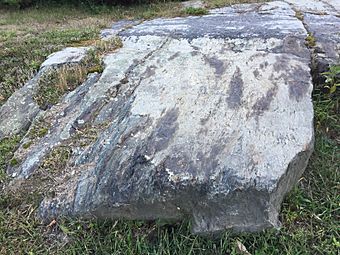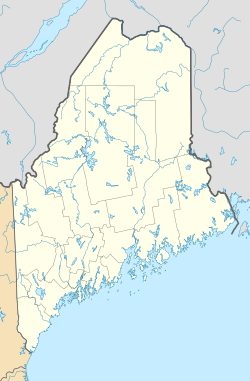Agassiz Bedrock Outcrop facts for kids
Quick facts for kids |
|
|
Agassiz Bedrock Outcrop
|
|
 |
|
| Location | 406 State St. Ellsworth, Maine |
|---|---|
| Area | 1.2 acres (0.49 ha) |
| Built | 1864 |
| NRHP reference No. | 03000014 |
| Added to NRHP | February 13, 2003 |
The Agassiz Bedrock Outcrop is a unique rock formation in Ellsworth, Maine. It is very important in the history of geology, which is the study of Earth's rocks and how they change. This outcrop is a piece of rock called Ellsworth schist. It has special marks called striations. These marks were made by huge glaciers moving across the land thousands of years ago.
A famous scientist named Louis Agassiz studied this rock in 1864. He was a geologist from Harvard University. His important paper, Glacial Phenomena in Maine, talked about what he found here. The Agassiz Bedrock Outcrop was added to the National Register of Historic Places in 2003. This means it is a historically important site.
Contents
What is the Agassiz Bedrock Outcrop?
The Agassiz Bedrock Outcrop is a large area of rock found on the side of State Street. You can see two main parts of this rock formation. One part is at the southeast corner of the property at 406 Main Street. The other part is at the northeast corner. A gravel driveway runs over the rock between these two visible sections.
Looking Closely at the Rock
The southeastern part of the rock is about 20 feet (6 meters) wide and long. It has a smooth surface. On this smooth surface, you can see several parallel lines or scratches. These are the striations made by glaciers.
The northeastern part of the rock is larger, about 30 by 50 feet (9 by 15 meters). This section has deeper grooves. It is possible to see how these grooves connect across the driveway. They show the path of stones that were dragged by the moving glacier. The buildings on the property are not part of the historical importance.
How This Rock Helped Science
In the mid-1800s, scientists were debating how certain marks on rocks in northern New England were made. Many people believed these marks were caused by icebergs floating during a great flood, like the one mentioned in the Bible.
The Idea of Glaciers
In 1859, an amateur geologist named John DeLaski from Rockland, Maine, suggested a new idea. He thought that a massive glacier had caused these marks. However, his idea did not get much attention at first.
Then, in the summer of 1864, Louis Agassiz visited Maine. He was a professor at Harvard. He studied many rock locations, from the coast all the way to Mount Katahdin. His research helped to prove DeLaski's idea.
Agassiz's Big Discovery
Agassiz wrote about his findings in his 1867 paper, Glacial Phenomena in Maine. In this paper, he suggested that North America, like parts of Europe, had once been covered by huge sheets of ice. This period is now known as the Wisconsin glaciation.
He specifically mentioned the "splendid polished surfaces" at Ellsworth Falls. He noted that these surfaces had "scratches and furrows pointing due north." These marks were strong evidence that a giant glacier had moved across the land, leaving its traces behind. The Agassiz Bedrock Outcrop was a key piece of this important scientific puzzle.



